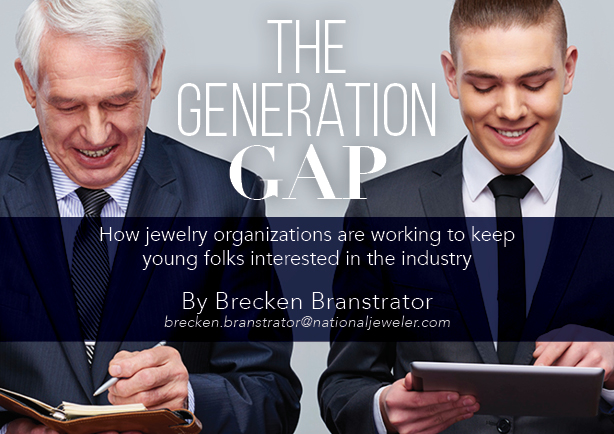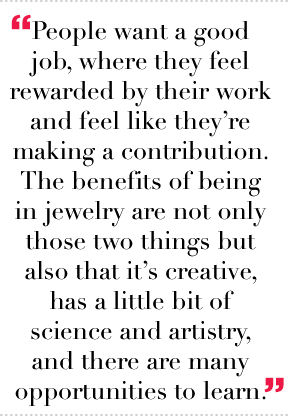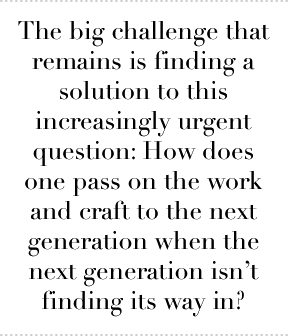


Antiques “Young Gun” Andrew Skipper, left, exchanges cards with Ruby Lane founder and CEO Tom Johnson at the Antiques Young Guns press conference in March. A program U.S. Antiques show brought over from the U.K., Young Guns is designed to stimulate the younger generation’s interest in the market for older things.

Antiques “Young Gun” Andrew Skipper, left, exchanges cards with Ruby Lane founder and CEO Tom Johnson at the Antiques Young Guns press conference in March. A program U.S. Antiques show brought over from the U.K., Young Guns is designed to stimulate the younger generation’s interest in the market for older things.

Members of the steering committee of the American Gem Society’s Young Titleholders program celebrate Mardi Gras-style at the President’s Party at Conclave, which took place in New Orleans this year.
Members of the steering committee of the American Gem Society’s Young Titleholders program celebrate Mardi Gras-style at the President’s Party at Conclave, which took place in New Orleans this year.

It’s an interesting, and tough, time for the younger generation to be entering the job market.
On one hand, the increased competition from varying sectors have created so many options that it can be almost overwhelming for them. On the other hand, open positions in some areas of the job market still seem to be few and far between.
In the jewelry industry, this increased competition for the younger generation’s attention and the decreased visibility of jewelry as a category in general is creating a big problem, as all segments of the industry witness the older generation retiring without many younger professionals to replace them.
Quite a number of organizations in the industry have taken notice and are working to reverse the trend.
The big challenge that remains is finding a solution to this increasingly urgent question: How does one pass on the work and craft to the next generation when the next generation isn’t finding its way in?
Options not presented
These days, the jewelry industry is not an obvious option for someone considering where they want to spend their professional lives. Designing might be an apparent career choice to the general population, but other facets of the industry such as stone cutting, sourcing, grading, sales, merchandising and appraising are less familiar.
Many of the industry organizations that have been trying to figure out why new talent is slow to find its way into the industry are pointing their fingers at this as the one big culprit: Young adults don’t even know they can get jobs in the industry. When they’re at the all-important part of their lives where they decide which colleges or trade schools might give them the best programs for the careers they want, jewelry isn’t being put in front of them.
MJSA, for its part, has its “Be a Jeweler” program, which offers anyone who’s interested in a career in jewelry a network of mentors to find the resources and training they might need to get started. Rich Youmans, chief communications officer and publisher, says that “The biggest obstacle is getting the word out there, making as many connections as possible, and not just through our members, but finding different outlets where students are going.”
The Diamond Council of America also sees the importance of and value in drumming up interest in the industry at an earlier age, using its Jewelry Career Readiness Initiative to help create qualified job candidates for the retail jewelry industry.
Using DCA’s accredited courses in diamonds, colored gemstones and jewelry sales, more and more high school students across the country are beginning to see what opportunities they have in the industry. JCRI Director Suzan Alexander Weir says that this school year, they’re likely will be more than a dozen high schools across the country offering jewelry-related classes.
Mary Moses Kinney, director of the Independent Jewelers Organization, says the IJO has noticed a huge interest in its seminars and education sessions that deal with transitioning a business from one generation to the next, and how retailers can stay relevant to the next generation.
This is a big part of what led them to creating the Millennial Advisory Board. “We’re trying to be proactive and get ahead of … anything keeping (millennials) away,” she says.
Now, at each of the IJO’s semi-annual conferences the millennials will meet with IJO board member Dina Unwin, of independent retailer Sterling Jewelers in Wethersfield, Conn., who then will take their comments and concerns back to the organization’s board of directors.
The group just had its first meeting this summer, and Unwin confirmed that one of the things they have been discussing is how they can get new people interested in the industry.
She recently attended a team clinic event during an IJO show, where she met with more than 50 millennials and asked the group if anyone had talked to them about jewelry as a career option while they were in school. Not one raised their hand. “Local schools aren’t talking about it. Colleges aren’t talking about it. I see it as a huge problem,” she says.
Unwin believes that meeting them in their space is the best way to solve this issue. Aiming to remedy the situation, she is reaching out to local schools in her area to see if they can do a career day, offer resources or provide any other type of education to spread awareness to students about jewelry jobs at this pivotal age.
The lack of a generic marketing campaign for jewelry—which many blame for the drop in sales—may also be having an impact here, Unwin says.
When De Beers stopped their broad campaign for diamond jewelry a few years ago, jewelry was no longer top of mind for consumers, who these days have competition for their spending money in many other segments, especially tech.
“Fifteen or 20 years ago, a couple wouldn’t have thought twice about making a large jewelry purchase,” Unwin says. “Now, we see people coming in who don’t necessarily understand the value of it or they say, ‘I don’t have anywhere to wear this so why would I spend the money on it?’”
Out of sight may not only mean out of mind when it comes to buying, but also when it comes to considering job opportunities.
Unwin also notes another interesting issue that the IJO’s Millennial Advisory Board has raised—communication between older generations and the younger, but not in the way that most people might think.
What they’re concerned with is that there seems to be plenty of education for how an older employee might sell to the millennial, but there doesn’t seem to be much for the reverse. Seeing that the younger generation is clamoring for it, providing education and training on this topic could be pivotal for a young employee.
Lending a helping hand
The lack of interest from the younger generation isn’t an abstract idea. It’s rearing its ugly head in real ways.
Dan Darby, vice president and group show director of U.S. Antique Shows, says when he was looking at the show calendar this year, he noticed that there were six fewer major shows scheduled for the antique jewelry market than there were just two years ago.
“It’s a scary prospect for antiques,” he tells National Jeweler. “Not only is there less interest in buying antiques these days, but there’s less interest in getting into this industry.” He also notes that he’s seeing less and less of the generational succession that has marked the category for so long—an issue not unfamiliar to retailers of all types of jewelry today.
To face the issues head on, U.S. Antique Shows launched “Antique Young Guns” in April. After seeing the success that the original program was having over in the U.K., the company licensed the name and brought it stateside.
The program gives individuals 39 years old and younger who are interested in working in antiques of any kind access to mentorship, exposure through the online Antique Young Guns marketplace, and the chance to connect with antique dealers in the United States and overseas, among other benefits.
Antique Young Guns directly attacks another possible issue for the Generation Y crowd that a few organizations have mentioned: intimidation and worrying about how much has to be learned, how much training could be needed, and from where they would get it. Those who are second-, third-, and fourth-generation members of the jewelry industry usually grow up seeing how it works firsthand and have family to guide them through all obstacles, but anyone who is new to the industry obviously isn’t so lucky.
The American Gem Society also hopes to lend a helping hand to the next generation by offering them networking and education opportunities, which is why it brought back its Young Titleholders group a few years ago.
“I have felt that, over the last three Conclaves or so, there’s been a groundswell of both awareness of and representation for the younger generation,” says co-founder and co-chair Lisa Bridge, adding that the members are attracted to the mentor panels and one-on-one sessions to keep them going.
AGS’s annual Conclave event has been a major part of the group’s focus lately, including keeping it affordable to make sure a younger crowd can attend and bringing in speakers who will appeal to that group as well.
The success of the Young Titleholders also stems from the willingness of the more established generation to offer their help and advice and do what it takes to get them involved.
“People do believe it’s important to bring in and engage this group and offer them strategic support as they’re getting their footing in the industry,” Bridge says.
For U.S. Antique Shows and its Young Guns program, offering this same type of support seems to be working.
Darby says their goal is to get 100 members within the first year, and he believes that not only are they well on their way to achieve that, but that the group is on a road to success. Offering members a connection to mentors, guidance and training seems to make a huge difference.
“Those who didn’t inherit a place in (the industry), they need to ask themselves what can they do to make sure that they’re offering the kind of help they needed when they first started,” he says.
Ross Nacht, fourth generation at Bernard Nacht & Co. and a member of Antique Young Guns, says the program will go a long way in attracting new blood into the antiques industry by offering mentorship they might not find elsewhere as well as putting the industry back on the map.
He adds that a big part of the group’s success going forward will be to first recruit enough younger members who are already in the industry so potential new members will see their peers already in the space.
Nacht also believes that it’s all about education, on both an industry and a consumer level. “If we educate the consumer more, it’s only going to help the trade,” he says.
On the flip side
It’s no secret that while the economy seems to be slowly recovering, spending, from all ages, still can be tight. The trickle-down effect for a younger professional might mean that even if they were interested in getting involved, cost could be a factor.
In addition to its new program, U.S. Antique Shows also lowered the cost of admission for the October Lueur show.
The International Colored Gemstone Association did the same, dropping the registration fee for younger members to attend its congress in May to nearly a third of the original price.
“We regard it as very important that we encourage the younger generation of gemstone professionals to attend the congress and other international events related to the colored gemstone business,” ICA President Benjamin Hackman said at the time.
Yet, at the same time, money isn’t everything to the younger crowd.
Study after study shows that millennials are looking for more than just a good salary and decent benefits when they choose a career. They want, according to millennial-focused professional network Levo, a job that will give them “purpose.”
Levo’s studies and focus groups indicate that 84 percent of 18- to 34-year-olds rank purpose as the top factor when evaluating if a job is right for them or if they want to stay. In addition to that, they want to know that the company they’re working for is socially responsible.
“People want a good job, where they feel rewarded by their work and feel like they’re making a contribution,” MJSA’s Youmans said. “The benefits of being in jewelry are not only those two things, but also that it’s creative, has a little bit of science and artistry, and there are many opportunities to learn.”
Not to mention, fine jewelry has a pretty unique place in people’s lives.
Think about it—when is jewelry most often given? When someone gets down on one knee, asks those four words and hopes the answer is yes; to commemorate a special occasion or time in someone’s life; or when there is a desire to own a piece that will be passed down through generations.
Who doesn’t like the idea of being a part of a happy moment in someone’s life? Most people in the industry would likely say it’s one of the best parts, if not their favorite part, about working in jewelry.
This should be a huge part of recruiting for the industry, for manufacturers, designers and retailers looking to build their sales team.
It remains to be seen, however, how effective these tools and more will be in turning up the younger generation’s interest in the industry. ![]()
